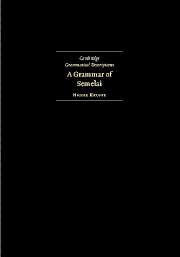Book contents
- Frontmatter
- Dedication
- Contents
- Tables and figures
- Preface
- Acknowledgements
- Abbreviations and conventions
- Maps
- 1 Semelai
- 2 Phonology and phonotactics
- 3 Morphology
- 4 Word classes
- 5 The verb
- 6 Pronouns: personal, ignorative, and demonstrative
- 7 The noun phrase
- 8 Prepositions and the prepositional phrase
- 9 Grammatical relations, constituent order and coding strategies
- 10 Basic clauses
- 11 Complex clauses
- 12 Expressives
- 13 The quotative marker, interjections and discourse clitics
- 14 Texts
- Vocabulary
- References
- Index
3 - Morphology
Published online by Cambridge University Press: 05 November 2014
- Frontmatter
- Dedication
- Contents
- Tables and figures
- Preface
- Acknowledgements
- Abbreviations and conventions
- Maps
- 1 Semelai
- 2 Phonology and phonotactics
- 3 Morphology
- 4 Word classes
- 5 The verb
- 6 Pronouns: personal, ignorative, and demonstrative
- 7 The noun phrase
- 8 Prepositions and the prepositional phrase
- 9 Grammatical relations, constituent order and coding strategies
- 10 Basic clauses
- 11 Complex clauses
- 12 Expressives
- 13 The quotative marker, interjections and discourse clitics
- 14 Texts
- Vocabulary
- References
- Index
Summary
In this chapter, the morphemic composition of words is examined, and an overview of the morphology is given in terms of the processes of word formation. The discussion of the various morphological processes will be organised according to the formal structures of process. A brief description of the function will be given, but the main discussion will be found in subsequent chapters.
The chapter begins with a description of theoretical preliminaries in §3.1 and an overview of the forms and processes. Affixation is organised into two sections according to the sub-systems which operate at this level: the indigenous system will be discussed in §3.2.2, and the loan system in §3.2.3. In §3.2.4 cases of archaic non-concatenative affixation are examined. Cliticisation is discussed in §3.3.
In the following discussion of morphology no particular theoretical model is adopted, although my treatment of the non-concatenative nature of the morphology processes draws broadly on the theories of prosodic morphology and template morphology. Descriptive tools have been adapted from consideration of the works of McCarthy (1981), Marantz (1982), Broselow and McCarthy (1983), Ter Mors (1983), and McCarthy and Prince (1990) to account for the features of Semelai morphology.
The term non-concatenative is adopted here pace McCarthy (1981) in its extended application used to account for reduplication processes (see also Spencer 1991, Gafos 1994).
- Type
- Chapter
- Information
- A Grammar of Semelai , pp. 61 - 93Publisher: Cambridge University PressPrint publication year: 2004

